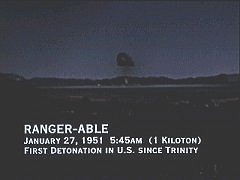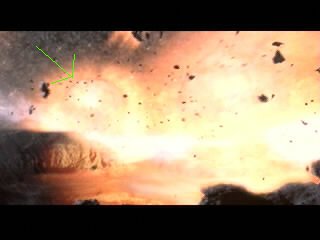
The reasons this page came about is because of a little twerp at Spacebattles.com who seems to think that the nuke bazookas shown in Starship Troopers make their Mobile Infantry the best military in sci-fi. That is a load of crap, Imperial ground forces from Star Wars, BattleTech ground forces, Warhammer 40K, and many other universes could easily outfight the Mobile Infantry on the ground. What this fool seems to not realize is that the modern US has built such devices, and this was back in the 50s and 60s. The 1 kiloton "Ranger-Able", for instance, and the Davy Crockett bazooka which had a larger blast radius.
Picture of Ranger-Able, supplied by Brian Young:

In order to determine the blast radius, I observed the end of Starship Troopers.
This is when Ace, Rico, and Ibanez left Watters behind:

This is when the weapon went off:

The time elapsed is precisely fifteen seconds.
This is at the very edge of the explosion:

A full thirteen seconds later.
The nuke did NOT harm them. In fact, it's explosion stopped short of them.
Since the explosion was short of them, the 23 second number gives them the time to jump an extra few yards, so my previous number of 20 seconds will remain. Now, since a time of 4.4 seconds for the 40-yard dash is considered very good in the NFL, we'll use this to measure. Why?
A) Rico himself played a futuristic version of football, and seemed to play a position relative to modern day receivers.
B) Speed is something that is very important in the NFL, especially for receivers, running backs, and cornerbacks (defensive backs). Thus I can rely on their standards.
4.4 seconds is actually a higher-end score, and usually achieved when the runner is running with only his weight (wearing running shorts and maybe a tank top exercise shirt or something to that effect). Add the weight of his armor and gun, maybe 30 something pounds, and a speed of 5.5 for forty yards is good (it could even be higher). Now, you might say "these are futuristic weapons, so they're light weight", but remember that they have to carry the ammunition too, and that can be just as heavy as the gun itself, especially if the gun is fully loaded and happens to carry large amounts of ammunition (seeing as how they rarely reloaded in the movie, that would be likely). So we have to take this into account.
Now assuming twenty seconds between starting and explosion (and that's damned generous), they could run 144 yards (20/5.5=3.6x40=144), or 132.9 meters.
Or if we're fair to them and change their time to 5 seconds for 40 yards instead of 5.5 seconds, you get 20/5=4x40=160, so 160 yards or 147.7 meters.
If we're ridiculously fair to them, and give them a time of 4.4 seconds for 40 yards, you get 20/4.4=4.5x40=181.8, so 181.8 yards or 167.8 meters. And this is highly unlikely, as all three had rifles and Rico and Ace also had armor.
However, let's try a far more realistic time of 6 seconds for 40 yards (remember that we have to account for the extra weight they carry). So now we get 20/6=3.3x40=133.3 yards, or 123 meters.
These all indicate an extremely weak yield. The Davy Crockett bazooka nuke the US Army tested in the 50s and 60s had a better blast radius (one mile IIRC). The "Ranger-Able" may have had a comparable blast radius, and it was a kiloton only. In fact, the RA is probably better too, considering just how weak those explosions are (they never blew the tops of the bug hole caves), so we're looking at a yield equal to or less than 1 kiloton.
No fission explosion can be so low, and the notable absence of a true mushroom cloud in the Klendathu explosion points to the nukes not being nuclear charges, but conventional. Thus the term "nuke" becomes a slang term, possibly because of the mini-mushroom cloud that such nukes give off when detonated (they form too quickly to be true mushroom clouds like those seen with nuclear detonations).
Pic of Weapon Detonations on Klendathu:

Click Here to Download .mpg of nukes exploding: 670KB
Even closing bugholes would seem to require a less-dangerous charge. A modern chemical charge could probably accomplish the problem of closing bugholes. Indeed, one could possibly attach a stick of dynamite to an arrow and use a bow to shoot the dynamite into the bughole, although that leaves the question on whether the archer has the time to get the arrow off. Still, using these weapons hardly seems worth the risk and trouble.
Conclusion: MI bazooka nukes are ideal for one reason: closing bugholes and such. It is not useful in tactical situations because the distance covered is not sufficient to ensure that the nuke is launched BEFORE enemy troops kill the soldier trying to launch it. It is a deadend and frankly, if not for the need to close bugholes, it would be a stupid endeavor and another example of military stupidity in the Starship Troopers movie. Indeed, one wonders why the MI does not use conventional charges instead of these dangerous high explosives.
Also, such charges would be useful as artillery, and against trenches. But we see no evidence of the Mobile Infantry using artillery outside of the nuke bazooka (and bazookas are typically anti-vehicle weapons, not artillery)
Acknowledgements:
LCpl. Joshua "Anakha" Ross USMC, for insights on the weight of modern weaponry, the pure difficulty when running with 30 pounds extra weight.
Brian Young, for mentioning "Ranger-Able", observing that the nuke charge would be fission instead of fusion, pointing out the usefulness of the nuke charges as artillery, pointing out the weight of ammunition in addition to weapons, coming up with that interesting "archery" idea, and just listening to my first attempt at a serious technical calculation.
Mike Wong, for generously giving me stills from the movie, and discussion about the nuke bazooka not being a true nuclear charge.